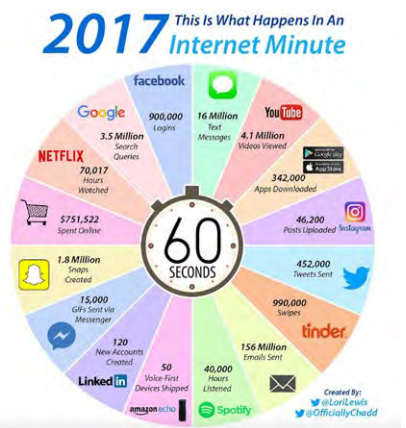22.1: History of the Internet
- Page ID
- 43349
\( \newcommand{\vecs}[1]{\overset { \scriptstyle \rightharpoonup} {\mathbf{#1}} } \)
\( \newcommand{\vecd}[1]{\overset{-\!-\!\rightharpoonup}{\vphantom{a}\smash {#1}}} \)
\( \newcommand{\id}{\mathrm{id}}\) \( \newcommand{\Span}{\mathrm{span}}\)
( \newcommand{\kernel}{\mathrm{null}\,}\) \( \newcommand{\range}{\mathrm{range}\,}\)
\( \newcommand{\RealPart}{\mathrm{Re}}\) \( \newcommand{\ImaginaryPart}{\mathrm{Im}}\)
\( \newcommand{\Argument}{\mathrm{Arg}}\) \( \newcommand{\norm}[1]{\| #1 \|}\)
\( \newcommand{\inner}[2]{\langle #1, #2 \rangle}\)
\( \newcommand{\Span}{\mathrm{span}}\)
\( \newcommand{\id}{\mathrm{id}}\)
\( \newcommand{\Span}{\mathrm{span}}\)
\( \newcommand{\kernel}{\mathrm{null}\,}\)
\( \newcommand{\range}{\mathrm{range}\,}\)
\( \newcommand{\RealPart}{\mathrm{Re}}\)
\( \newcommand{\ImaginaryPart}{\mathrm{Im}}\)
\( \newcommand{\Argument}{\mathrm{Arg}}\)
\( \newcommand{\norm}[1]{\| #1 \|}\)
\( \newcommand{\inner}[2]{\langle #1, #2 \rangle}\)
\( \newcommand{\Span}{\mathrm{span}}\) \( \newcommand{\AA}{\unicode[.8,0]{x212B}}\)
\( \newcommand{\vectorA}[1]{\vec{#1}} % arrow\)
\( \newcommand{\vectorAt}[1]{\vec{\text{#1}}} % arrow\)
\( \newcommand{\vectorB}[1]{\overset { \scriptstyle \rightharpoonup} {\mathbf{#1}} } \)
\( \newcommand{\vectorC}[1]{\textbf{#1}} \)
\( \newcommand{\vectorD}[1]{\overrightarrow{#1}} \)
\( \newcommand{\vectorDt}[1]{\overrightarrow{\text{#1}}} \)
\( \newcommand{\vectE}[1]{\overset{-\!-\!\rightharpoonup}{\vphantom{a}\smash{\mathbf {#1}}}} \)
\( \newcommand{\vecs}[1]{\overset { \scriptstyle \rightharpoonup} {\mathbf{#1}} } \)
\( \newcommand{\vecd}[1]{\overset{-\!-\!\rightharpoonup}{\vphantom{a}\smash {#1}}} \)
\(\newcommand{\avec}{\mathbf a}\) \(\newcommand{\bvec}{\mathbf b}\) \(\newcommand{\cvec}{\mathbf c}\) \(\newcommand{\dvec}{\mathbf d}\) \(\newcommand{\dtil}{\widetilde{\mathbf d}}\) \(\newcommand{\evec}{\mathbf e}\) \(\newcommand{\fvec}{\mathbf f}\) \(\newcommand{\nvec}{\mathbf n}\) \(\newcommand{\pvec}{\mathbf p}\) \(\newcommand{\qvec}{\mathbf q}\) \(\newcommand{\svec}{\mathbf s}\) \(\newcommand{\tvec}{\mathbf t}\) \(\newcommand{\uvec}{\mathbf u}\) \(\newcommand{\vvec}{\mathbf v}\) \(\newcommand{\wvec}{\mathbf w}\) \(\newcommand{\xvec}{\mathbf x}\) \(\newcommand{\yvec}{\mathbf y}\) \(\newcommand{\zvec}{\mathbf z}\) \(\newcommand{\rvec}{\mathbf r}\) \(\newcommand{\mvec}{\mathbf m}\) \(\newcommand{\zerovec}{\mathbf 0}\) \(\newcommand{\onevec}{\mathbf 1}\) \(\newcommand{\real}{\mathbb R}\) \(\newcommand{\twovec}[2]{\left[\begin{array}{r}#1 \\ #2 \end{array}\right]}\) \(\newcommand{\ctwovec}[2]{\left[\begin{array}{c}#1 \\ #2 \end{array}\right]}\) \(\newcommand{\threevec}[3]{\left[\begin{array}{r}#1 \\ #2 \\ #3 \end{array}\right]}\) \(\newcommand{\cthreevec}[3]{\left[\begin{array}{c}#1 \\ #2 \\ #3 \end{array}\right]}\) \(\newcommand{\fourvec}[4]{\left[\begin{array}{r}#1 \\ #2 \\ #3 \\ #4 \end{array}\right]}\) \(\newcommand{\cfourvec}[4]{\left[\begin{array}{c}#1 \\ #2 \\ #3 \\ #4 \end{array}\right]}\) \(\newcommand{\fivevec}[5]{\left[\begin{array}{r}#1 \\ #2 \\ #3 \\ #4 \\ #5 \\ \end{array}\right]}\) \(\newcommand{\cfivevec}[5]{\left[\begin{array}{c}#1 \\ #2 \\ #3 \\ #4 \\ #5 \\ \end{array}\right]}\) \(\newcommand{\mattwo}[4]{\left[\begin{array}{rr}#1 \amp #2 \\ #3 \amp #4 \\ \end{array}\right]}\) \(\newcommand{\laspan}[1]{\text{Span}\{#1\}}\) \(\newcommand{\bcal}{\cal B}\) \(\newcommand{\ccal}{\cal C}\) \(\newcommand{\scal}{\cal S}\) \(\newcommand{\wcal}{\cal W}\) \(\newcommand{\ecal}{\cal E}\) \(\newcommand{\coords}[2]{\left\{#1\right\}_{#2}}\) \(\newcommand{\gray}[1]{\color{gray}{#1}}\) \(\newcommand{\lgray}[1]{\color{lightgray}{#1}}\) \(\newcommand{\rank}{\operatorname{rank}}\) \(\newcommand{\row}{\text{Row}}\) \(\newcommand{\col}{\text{Col}}\) \(\renewcommand{\row}{\text{Row}}\) \(\newcommand{\nul}{\text{Nul}}\) \(\newcommand{\var}{\text{Var}}\) \(\newcommand{\corr}{\text{corr}}\) \(\newcommand{\len}[1]{\left|#1\right|}\) \(\newcommand{\bbar}{\overline{\bvec}}\) \(\newcommand{\bhat}{\widehat{\bvec}}\) \(\newcommand{\bperp}{\bvec^\perp}\) \(\newcommand{\xhat}{\widehat{\xvec}}\) \(\newcommand{\vhat}{\widehat{\vvec}}\) \(\newcommand{\uhat}{\widehat{\uvec}}\) \(\newcommand{\what}{\widehat{\wvec}}\) \(\newcommand{\Sighat}{\widehat{\Sigma}}\) \(\newcommand{\lt}{<}\) \(\newcommand{\gt}{>}\) \(\newcommand{\amp}{&}\) \(\definecolor{fillinmathshade}{gray}{0.9}\)| 1958 | US ARPA (Advanced Research Projects Agency) established to lead science and military technological developments. |
| 1961 | MIT research paper on Packet Switching Theory. |
| 1961-69 | Ongoing research into inter-computer communications and networks. |
| 1969 | ARPANET, commissioned by US Defense Department, goes live. US universities connect up network facilities for the first time. |
| 1971 | Ray Tomlinson creates first network email application. |
| 1973 | Development of protocols to enable multi-network Internet opportunities. First international ARPANET connections made. |
| 1976 | HM Queen Elizabeth II sends an email. |
| 1978 | First spam email is recorded. |
| 1980 | Tim Berners-Lee develops rules for the World Wide Web and is credited as the Web Father. Alan Emtage develops the first search tool, known as ‘ARCHIE’. |
| 1982 | Standard network protocols are established: Transmission Control Protocol (TCP) and Internet Protocol (IP), commonly referred to as TCP/IP. |
| 1984 |
Joint Academic Network (JANET) is established, linking higher education institutions. Domain Name System (DNS) is introduced. |
| 1985 | A company named Symbolics becomes the first registered dot-com domain. |
| 1987 |
National Science Foundation (US) is the catalyst for the surge in funded work into the Internet. Number of Internet hosts increases significantly in this period. |
| 1988-90 | 28 countries sign up to hook up to the NSFNET, reinforcing international Internet potential. |
| 1990 | Senator Al Gore coins the term ‘information superhighway’. |
| 1991 | Web Father Tim Berners-Lee releases World Wide Web (www) with scientists from CERN. |
| 1992 |
America Online (AOL) is launched and raises $23m in floatation. The term ‘surfing the net’ is introduced by Jean Armour Polly. The World Bank goes online. |
| 1993 |
Mainstream media attention increases awareness of the Internet. The first Internet publication, Wired, goes on sale. Mosaic introduces the first web browser with graphical interface and is the forerunner of Netscape Navigator. First online shopping malls and virtual banks emerge, as does evidence of spam. First clickable banner advert is sold by Global Network Navigator to a law firm. |
| 1995 |
Amazon is launched by Jeff Bezos. Trial dial-up systems such as AOL and CompuServe launch. Charging is introduced for domain names. Search technology companies such as Alta Vista, Infoseek, Excite and Metacrawler rapidly appear. |
| 1996 | Yahoo! is launched on the stock exchange and shares are up nearly 300% on first day. |
| 1997 | MP3.com is founded. The term ‘search engine optimisation’ is used for the first time in a forum. |
| 1998 | XML is released to enable compatibility between different computer systems. Google founded by Larry Page and Sergey Brin. |
| 1999 | Peter Merholz coins the word ‘blog’. |
| 2000 |
AOL and Time-Warner announce that they are merging. Pay-per-click campaigns are introduced for top ten search rankings. Google AdWords launches, charging for adverts on a CPM basis. |
| 2002 |
UK online monthly consumer shopping breaks through the £1 billion barrier. Google AdWords charges on a PPC basis instead of CPM. |
| 2003 | eBay topples Amazon as the most visited UK website. |
| 2004 |
CD-WOW loses court case and rights to source cheaper CDs outside EU, undermining the global concept of the Internet. Facebook launches from the Harvard dorm room of Mark Zuckerberg, Dustin Moskovitz, Chris Hughes and Eduardo Saverin. |
| 2005 |
Iceland leads the world with broadband penetration: 26.7 inhabitants per 100 have broadband compared with 15.9 per 100 in the UK. YouTube launches. Google buys Android Inc. |
| 2006 |
Google buys YouTube for $1.6 billion. Facebook membership opens to everyone. Twitter launches. Technorati notes that a blog is created every second of every day. TIME Magazine names ‘You’ as person of the year, as a result of online activity. |
| 2007 |
Facebook launches Facebook Ads. Apple launches the iPhone. The Google Phone, with the Android operating system, launches. Google launches Gmail. |
| 2008 |
Firefox 3.0 launches with over 8 million downloads in 24 hours. Groupon launches, to become the fastest growing company of all time. Google Chrome, a browser, launches. Apple opens the App Store. |
| 2009 |
Facebook adds the ‘like’ feature. Foursquare launches. |
| 2010 |
Facebook reaches 500 million users. 24 hours of video are uploaded to YouTube every minute. Pinterest launches. Apple releases the first iPad. Google launches Nexus One. The number of Internet users tops 1.9 billion worldwide. Instagram launches. Astronaut TJ Creamer sends the first tweet from space. |
| 2011 |
200 million tweets are sent daily on Twitter – about one billion a week. Social media is credited with a crucial role in political movements in Egypt, Tunisia and Libya. Apple’s App Store downloads top 10 billion. Google+ launches. YouTube reaches 1 trillion views. |
| 2012 |
Facebook tops 1 billion users. Apple releases the iPad Mini. The number of Internet users tops 2.4 billion worldwide. Online advertising spend surpasses print advertising spend for the first time. Facebook buys Instagram for $1 billion, as the service tops 100 million active users. |
| 2013 |
Video-sharing service, Vine, launches. Smartphone sales overtake feature phone sales globally. 100 hours of video are uploaded to YouTube every minute. Over 45 billion apps have been downloaded from the Apple App Store. |
| 2014 |
Number of Internet users hits 3 billion. Facebook buys messaging app WhatsApp for US $19 billion. Facebook introduces autoplay videos and provides video metrics as part of its native analytics package for brands and businesses. |
| 2015 |
Smartphones become the most popular device used to browse the Internet. WordPress powers 25% of websites. The use of mobile banking and payment apps rises by 54%. |
| 2016 |
The Internet of Things (IoT) gains momentum. From wearables to smart homes, increasingly things are becoming connected online. |
| 2017 |
Facebook hits 2 billion active monthly users. Big data and AI continue to change how we conduct business. Gaming becomes a 2.6 billion US$ dollar industry and voice begins to replace typing for online queries. |

What new developments have happened recently? Keep an eye on the news for digital updates.


